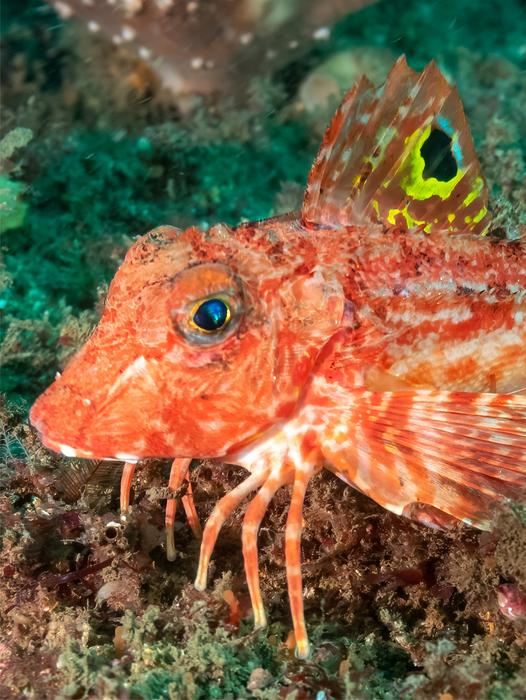After delivering a guest lecture on sticklebacks, an unfamiliar fish caught Stanford University researcher David Kingsley’s eye. When he walked past an aquarium at the Woods Hole Marine Biology Laboratory, a strange aquatic creature stopped him in his tracks.
“I did this huge double take because I looked in this one tank, and there was one of the weirdest fish I’ve ever seen,” says Kingsley. “It had the body of a fish, the wings of a bird, and it was walking along the bottom of the tank on six legs. It almost looked like a centaur or something.”
Series of Serendipity
That was the first of three serendipitous moments that led a team of biologists to understand how the fish, called a sea robin, uses its legs to find food. Not only do the legs have an acute sense of touch, but they also “wear” the piscine equivalents of taste buds on their feet. The scientists report the genetic reasons these strange features exist in a Current Biology report.
Before heading home to California, Kingsley loaded up his smartphone with papers about the sea robin. By the time he returned to Stanford, he decided to investigate how nature produced these curious traits.
The irony was, when Kingsley talks about the main creature he studies — the stickleback fish — he tends to focus on how organisms lose functions over time. But he’s repeatedly been asked about how nature introduces novel traits. The sea robin provided the perfect opportunity to explore that idea. So he and his lab began studying the sea robin’s genome.
Meanwhile, back on the East Coast, a Harvard group had also become fascinated by the sea robin. Their primary interest focused on how exactly the strange creature hunted for food on the ocean floor. That group had heard from Massachusetts fisherman that the sea robin was so good at finding buried food that other fish actually followed it.
Bottom Feeders
The Harvard group wanted to see just how good the sea robins were at discovering dinner. “We just put them in a tank, we put sand on the bottom. We went to the grocery store. We got some mussels. We buried them. And the sea robins found them right away,” says Nicholas Bellono of Harvard. The fish performed just as well detecting capsules containing different scents.
The Harvard researchers then began asking themselves about the molecular biology behind this ability. Unfortunately, the scientists weren’t as adept at identifying key molecules as the sea robin was at locating food. “We were just totally failing,” says Bellono. “We could not find anything because we really didn’t know where to look.”
Luck Favors the Prepared Mind
Then serendipity struck again. The group ran out of fish, so they sought another batch from Woods Hole. When they tested that group of fish’s food-finding ability, the new school kept coming up empty. “At first, I thought we messed up, like, maybe we did something wrong in the experimental setup,” says Bellono.
They soon discovered that they were looking at two separate species of sea robins. “That meant there was a whole [other] thing to study, which is not just what makes sea robins different from other fish, but what makes some sea robins different from other sea robins,” says Bellono.
Then, serendipitous moment Number Three struck. The Harvard group got word that a postdoc from the Stanford lab had been visiting the MBL every summer to work with sea robins. “We thought ‘well, if someone else in the world cares about these weird fish, we should probably work with them,” Bellono. The two teams complemented each other because the Stanford group had expertise in genetics and genomics, while the Harvard team excelled at sensory functions, behavior, and molecular biology.
When they compared genomes of the two different sea robin species, obvious differences jumped out. The species that excelled at finding food had genes that produced taste receptors on its feet. The other did not.
Further analyses revealed the genetic mechanisms that produced the successful food hunter’s sense of touch and taste on their legs. The experience serves as a reminder of why basic research is worthwhile. “I hope it serves as inspiration for people to just be curious about the world around them and try to understand how it works,” says Bellono.
It also emphasizes why science can be fun and exciting. The experience gave Kingsley a “kid in the candy store” feeling. “And for a biologist, the kid in the candy store might be a geneticist in an aquarium,” says Kingsley.
Source : Discovermagazine






